Root hairs are important to a plant because they _____.
protect the plant from freezing
protect the plant from soil microbes
help the root slide between soil particles
increase the surface area for absorption
develop into lateral roots
increase the surface area for absorption
How do cells in a meristem differ from cells in other types of plant tissue?
They are growing.
They photosynthesize at a faster rate.
They are differentiating.
They store food.
They continue to divide.
They continue to divide.
The primary growth of a plant adds _____ and secondary growth adds _____.
height ... branching
branching ... flowers
branching ... girth
height ... girth
girth ... height
height ... girth
Choose the option that best describes the relationship between the cell wall thickness of parenchyma cells versus sclerenchyma cells.
The cell walls of parenchyma cells are thinner than those of sclerenchyma cells.
The thickness of the cell walls for both types of cells is too variable for a comparison to be made.
The cell walls of collenchyma cells are thicker than sclerenchyma or parenchyma cells.
The cell walls of both types of cells are roughly equal.
The cell walls of parenchyma cells are thicker than those of sclerenchyma cells.
The cell walls of parenchyma cells are thinner than those of sclerenchyma cells.
Which structure is incorrectly paired with its tissue system?
tracheid–vascular tissue
palisade parenchyma–ground tissue
companion cell–ground tissue
guard cell–dermal tissue
root hair–dermal tissue
companion cell–ground tissue
Which of the following is derived from the ground tissue system?
cuticle
phloem
pith
periderm
root hair
pith
Which part of a plant absorbs most of the water and minerals taken up from the soil?
the thick parts of the roots near the base of the stem
sections of the root that have secondary xylem
root hairs
storage roots
root cap
root hairs
Vascular plant tissue includes all of the following cell types except
cambium cells.
companion cells.
sieve cells.
tracheids.
vessel elements.
cambium cells.
________ is to xylem as ________ is to phloem.
Vessel element; sieve-tube member
Sclerenchyma cell; collenchyma cell
Cortex; pith
Vascular cambium; cork cambium
Apical meristem; vascular cambium
Vessel element; sieve-tube member
Which of the following cells transport sugars over long distances?
sclerenchyma cells
collenchyma cells
sieve-tube elements
parenchyma cells
tracheids and vessel elements
sieve-tube elements
Which of the following have unevenly thickened primary walls that support young, growing parts of the plant?
tracheids and vessel elements
sclerenchyma cells
sieve-tube elements
parenchyma cells
collenchyma cells
collenchyma cells
The vascular bundle in the shape of a single central cylinder in a root is called the
endodermis.
cortex.
periderm.
stele.
pith.
stele.
One important difference between the anatomy of roots and the anatomy of leaves is that
leaves have epidermal tissue but roots do not.
a waxy cuticle covers leaves but is absent from roots.
only leaves have phloem and only roots have xylem.
root cells have cell walls and leaf cells do not.
vascular tissue is found in roots but is absent from leaves.
a waxy cuticle covers leaves but is absent from roots.
A student examining leaf cross sections under a microscope finds many loosely packed cells with relatively thin cell walls. The cells have numerous chloroplasts. What type of cells are they?
xylem
sclerenchyma
endodermis
collenchyma
parenchyma
parenchyma
CO2 enters the inner spaces of the leaf through the
cuticle.
epidermal trichomes.
phloem.
stoma.
walls of guard cells.
stoma.
Gas exchange, which is necessary for photosynthesis, can occur most easily in which leaf tissue?
palisade mesophyll
vascular tissue
bundle sheath
epidermis
spongy mesophyll
spongy mesophyll
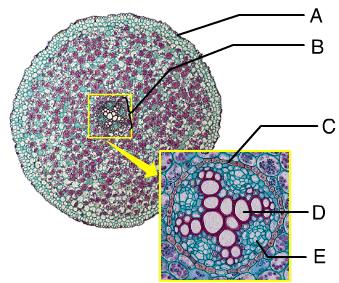
Xylem is indicated by the letter _____.
A
D
E
B
C
D
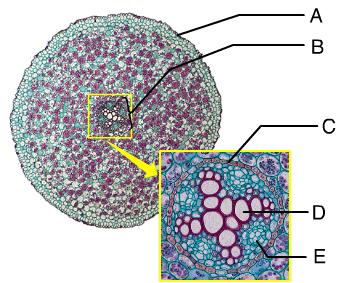
The letter A indicates the _____.
epidermis
xylem
vascular cylinder
cortex
endodermis
epidermis
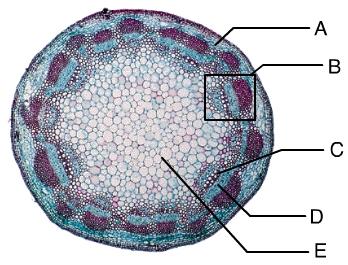
The letter A indicates the _____.
phloem
cortex
pith
xylem
vascular bundle
cortex

Pith is indicated by the letter _____.
E
B
C
A
D
E
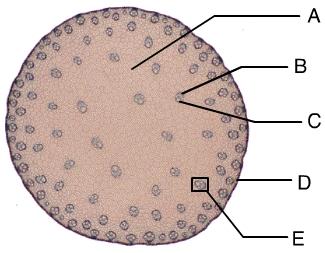
Ground tissue is indicated by the letter _____.
D
E
A
C
B
A
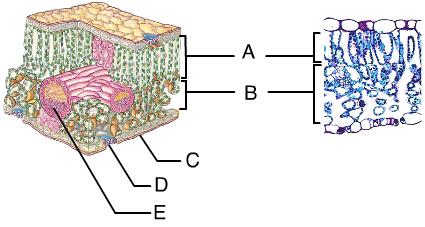
The region surrounded by guard cells is indicated by the letter _____.
D
C
A
B
E
D
Plants contain meristems whose major function is to
produce more cells.
produce flowers.
absorb ions.
photosynthesize.
attract pollinators.
produce more cells.
Axillary buds
do not form a vascular connection with the primary shoot.
are composed of a series of internodes lacking nodes.
grow immediately into shoot branches.
have dormant meristematic cells.
are initiated by the cork cambium.
have dormant meristematic cells.
The following question is based on parts of a growing primary root.
I. root cap
II. zone of elongation
III. zone of cell
division
IV. zone of cell differentiation
V. apical meristem
Which of the following is the correct sequence from the growing
tips of the root upward?
A) III, V, I, II, IV
B) II, IV, I, V, III
C) IV, II, III, I, V
D) I, II, V, III, IV
E) I, V, III, II, IV
E
Which of the following root tissues gives rise to lateral roots?
A) epidermis
B) cortex
C) endodermis
D) phloem
E) pericycle
E
Pores on the leaf surface that function in gas exchange are called
A hairs.
B xylem cells.
C stomata.
D phloem cells.
E sclereids.
C
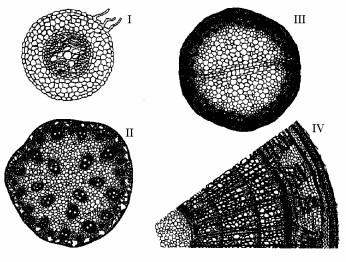
The following question is based on the drawing of root or stem cross
sections shown in the figure.
A woody eudicot is represented by
I only.
II only.
III only.
IV only.
both I and III.
IV only.
Secondary growth NEVER occurs in _____.
stems
leaves
roots and leaves
stems and leaves
roots
leaves
_____ provides cells for secondary growth.
Secondary xylem
Secondary phloem
Apical meristem
The root
Vascular cambium
Vascular cambium
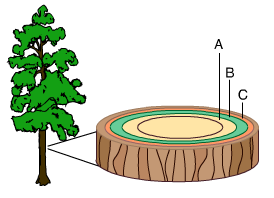
The letter A indicates _____.
secondary xylem
cork cambium
lateral meristem
vascular cambium
apical meristem
secondary xylem
Vascular cambium forms wood toward the stem's _____ and secondary phloem toward the stem's _____.
top ... bottom
surface ... center
center ... surface
center ... center
surface ... surface
center ... surface
What is the function of cork?
regulating the opening and closing of stomata
providing a site for photosynthesis
providing cells for primary growth
insulation and waterproofing
providing cells for secondary growth
insulation and waterproofing
How is the supply of vascular cambium maintained?
by the differentiation of secondary xylem
by the differentiation of secondary phloem
by the division of its cells
by the differentiation of cork
by the differentiation of apical meristem
by the division of its cells
Cell division in the vascular cambium adds to the girth of a tree by adding new _____ to the layer's interior and _____ to the layer's exterior.
xylem and phloem ... bark
pith ... xylem and phloem
xylem ... cortex
xylem ... phloem
phloem ... xylem
xylem ... phloem
As the epidermis is pushed outward and sloughed off, it is replaced by tissues produced by the _____.
cork cambium
lenticels
suberin
vascular cambium
pith
cork cambium
Which of the following cells or tissues arise from lateral meristem activity?
cortex
trichomes
leaves
secondary xylem
tubers
secondary xylem
A plant has the following characteristics: a taproot system, several growth rings evident in a cross section of the stem, and a layer of bark around the outside. Which of the following best describes the plant?
woody monocot
herbaceous eudicot
woody eudicot
herbaceous monocot
woody annual
woody eudicot
Which of the following is a true statement?
Secondary growth is produced by both the vascular cambium and the cork cambium.
Primary growth and secondary growth alternate in the life cycle of a plant.
Flowers may have secondary growth.
Secondary growth is a common feature of eudicot leaves.
Plants with secondary growth are typically the smallest ones in an ecosystem.
Secondary growth is produced by both the vascular cambium and the cork cambium.
What tissue makes up most of the wood of a tree?
primary xylem
vascular cambium
mesophyll cells
secondary xylem
secondary phloem
secondary xylem
If you were able to walk into an opening cut into the center of a large redwood tree, when you exit from the middle of the trunk (stem) outward, you would cross, in order,
A) the annual rings, new xylem, vascular cambium, phloem, and bark.
B) the vascular cambium, oldest xylem, and newest xylem.
C) the secondary xylem, cork cambium, phloem, and periderm.
D) the secondary xylem, secondary phloem, and vascular cambium.
E) the summer wood, bark, and phloem.
A
Which of the following is correctly matched with its tissue system?
cortex ... ground tissue system
xylem ... ground tissue system
phloem ... epidermis
pith ... vascular tissue system
guard cells ... ground tissue
cortex ... ground tissue system
What is the primary function of stems?
Facilitation of gas exchange
Water absorption and movement
Reproduction
Maximization of photosynthesis by leaves
Maximization of photosynthesis by leaves
One important difference between the anatomy of roots and the anatomy of leaves is that _____.
only leaves have phloem and only roots have xylem
a waxy cuticle covers leaves but is absent from roots
root cells have cell walls and leaf cells do not
vascular tissue is found in roots but is absent from leaves
leaves have epidermal tissue but roots do not
a waxy cuticle covers leaves but is absent from roots
Trichomes _____.
open and close for gas exchange
increase water loss from leaves
repel or trap insects
absorb sunlight, increasing the temperature of leaves
repel or trap insects
Which of the following is correctly paired with its structure and function?
guard cells – waterproof ring of cells surrounding the central stele in roots
sclerenchyma – supporting cells with thick secondary walls
ground meristem – protective coat of woody stems and roots
periderm – parenchyma cells functioning in photosynthesis in leaves
sclerenchyma – supporting cells with thick secondary walls
Which of the following are water-conducting cells that are dead at functional maturity?
parenchyma cells
tracheids and vessel elements
sieve-tube elements
collenchyma cells
tracheids and vessel elements
Which of the following cells transport sugars over long distances?
parenchyma cells
sclerenchyma cells
sieve-tube elements
tracheids and vessel elements
sieve-tube elements
Plant meristematic cells _____.
subdivide into three distinct cell types named parenchyma, ground meristem, and procambium
are undifferentiated cells that produce new cells
increase the surface area of dermal tissue by developing root hairs
are distributed evenly in all tissues throughout the plan
are undifferentiated cells that produce new cells
Which of the following cells or tissues arise from lateral meristem activity?
secondary xylem
tubers
trichomes
leaves
secondary xylem
Which of the following is the correct sequence of the zones in the primary growth of a root, moving from the root cap inward?
zone of cell division, zone of elongation, zone of differentiation
zone of differentiation, zone of elongation, zone of cell division
zone of elongation, zone of cell division, zone of differentiation
zone of cell division, zone of differentiation, zone of elongation
zone of cell division, zone of elongation, zone of differentiation
You find a plant unfamiliar to you and observe that it has vascular bundles scattered throughout the stem cross section. What do you conclude about the plant?
It will probably get annual rings of wood.
It is probably an herbaceous eudicot.
It could be either a young eudicot or a monocot.
It is probably a monocot.
It is probably a monocot.
The veins of leaves are _____.
I) composed of xylem and
phloem
II) continuous with vascular bundles in the stem and
roots
III) finely branched to be in close contact with
photosynthesizing cells
only I
only II
only III
I, II, and III
I, II, and III
Where is primary growth occurring in an old tree?
Nowhere; trees more than a year old have only secondary growth.
in young branches where leaves are forming
where the vascular cambium and cork cambium are located
closest to ground level at the base of the tree
in young branches where leaves are forming
What tissue makes up most of the wood of a tree?
secondary xylem
vascular cambium
primary xylem
secondary phloem
secondary xylem